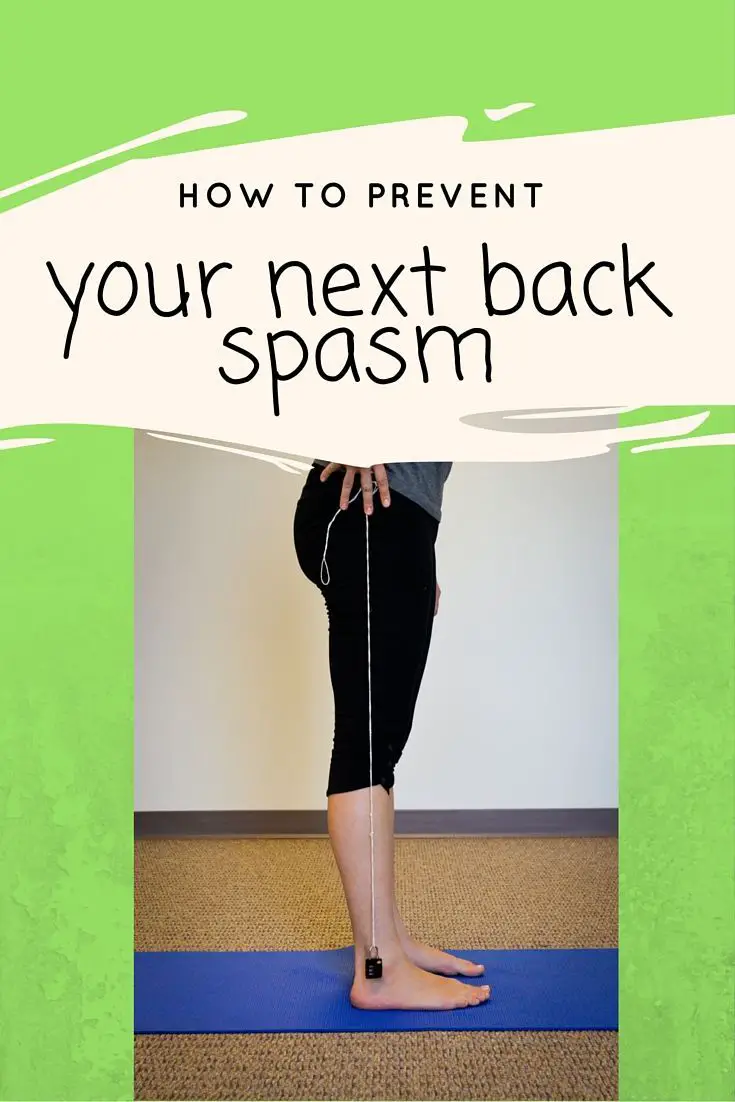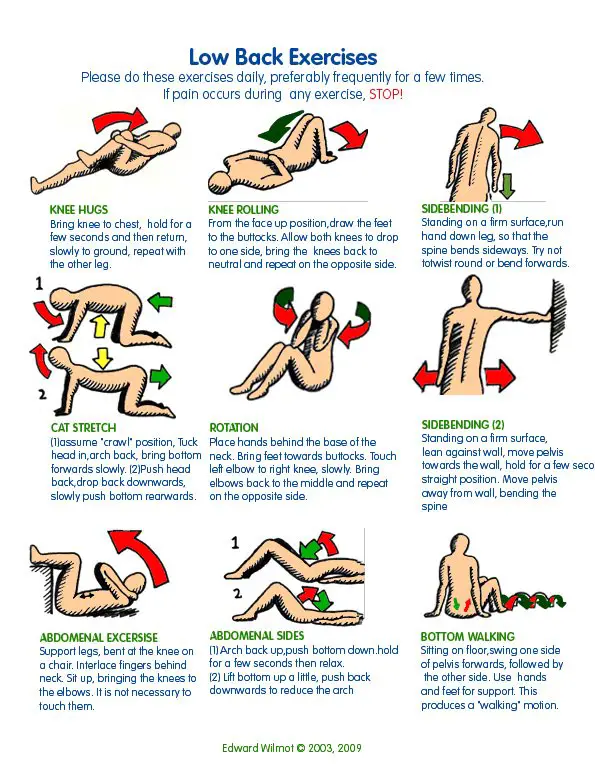What Is Lower Back Pain
Low back pain can result from many different injuries, conditions or diseases most often, an injury to muscles or tendons in the back.
Pain can range from mild to severe. In some cases, pain can make it difficult or impossible to walk, sleep, work or do everyday activities.
Usually, lower back pain gets better with rest, pain relievers and physical therapy . Cortisone injections and hands-on treatments can relieve pain and help the healing process. Some back injuries and conditions require surgical repair.
Inhale Slowly And Deeply For A Count Of 5 Seconds Pause 1 Second And Exhale 3
Visualization will help by imagining a tight knot being unraveled as you inhale. Picture the muscles extending as you inhale to stretch your rib cage fully.
As the muscles are contracting intensely, they are also over contracting, making it counter-productive.
Since you have already stopped moving, you are now trying to shut off the muscles need also to do this. Breathing deeply is key to relaxing a muscle which is becoming progressively shorter and more painful.
As you try to relax, avoid any movements that allow the muscle to shorten
Because of the intensity, duration and source of the injury, it is natural to react and to contract your body further. Even unwillingly.
To avoid this, focus on slowly inhaling while at the same time minimizing your movements. When in contraction, the reduced circulation and the build up of lactic acid makes you feel much worse.
Start These 2 Simple But Very Effective Exercises Now
What you can do now at this point is to practice these 2 simple exercises. They are among many specific and targeted exercises from the eBook which are the Seated Twist and the Lying Twist. They will help you both to loosen, strengthen and stabilize your spine, making it much easier for you to turn and reach to avoid triggering another spasm.
Reducing your back spasms will also reduce muscle guarding, a major factor which causes many to suffer from recurring pain in the morning.
The Seated and Lying Twist exercises help to release tight, lower back muscles which can fatigue and trigger a spasm. If you suffer from them, you may find that even these simple movements can be difficult to execute in full range.
As with all exercises, dont force yourself to perform the full stretch right away. You may cause more pain by doing this. Work your way up one degree or inch at a time very slowly over several days. Remember, your body is NOT accustomed to such movement.
It is common to trigger yourself by reaching or moving in a twisted position due to excessive tightness. They can strike during even the most mundane and simple of action such as reaching for a pen on the floor. These exercises help you to improve these tight areas to protect you.
- Dont Bend and Lift the Wrong Way. Try a Safer Way to Lift.
STRETCH AND STRENGTHEN THE MUSCLES THAT ARE PRONE TO SPASM WHILE CONDITIONING THE CORE MUSCLES THAT PROTECT YOU
Back spasms are NOT a quick fix problem.
You May Like: Aleve Lower Back Pain
Low Back Spasm How Do I Get Rid Of It
If you feel like a tightening, pulling or twitching of the muscle in your low back, it could be a painful back condition known as low back spasm. In such a situation the sufferer often gets confused, what to do and what not. Should they exercise or go for bed rest.
In this article, Im going to clear all your confusion regarding this. But to understand it better we first need to know what actually is a low back spasm and what causes it.
A Back Spasm Is A Muscle Cramp In Your Back It Could Be Just A Strained Back Muscle Or It Could Be Part Of A More Serious Back Problem Find Out What To Do And When To Call The Doctor

You’ll know when back spasms hit you the pain can be sudden and even intense.
Almost everyone gets back pain at some point. People may say they have a backache or back spasm, or that they threw their back out. These are all descriptions of acute low back pain, back pain that starts suddenly. A muscle spasm is another word for a muscle cramp. It happens when a muscle contracts and cant relax.
Muscle spasms are common in the back, says Dr. Dominic King, an orthopedic physician at the Cleveland Clinic Sports Health Center. When you get a muscle spasm in your leg, you call it a charley horse. It may be caused by muscle fatigue or dehydration. Muscle spasms in your back can have more causes. Your back muscles are big muscles that keep you up all day, so they can get stressed and fatigued, but they can also be affected by changes in your spine, explains Dr. King.
Recommended Reading: How Does A Diuretic Help Back Pain
What Causes A Back Spasm
A mild strain is one of the minor causes of back spasms. However, for some others, back spasms are triggered by more complex conditions such as a herniated or ruptured spinal disc. If you feel like your back muscles are moving or contracting firmly, you should look out for the following common causes.
When Should I Call My Healthcare Provider
- Youre unable to stand or walk.
- You have a temperature over 101.0°F
- You have frequent, painful, or bloody urination.
- You have severe abdominal pain.
- You have a sharp, stabbing pain.
- Your pain is constant.
- You have pain or numbness in your leg.
- You feel pain in a new area of your back.
- You notice that the pain isnt decreasing after more than a week.
Contact your healthcare provider immediately for the following:
- Pain radiating down the leg
- Pain that is accompanied by fever, weakness in the leg, or loss of control of the bladder or bowels
You May Like: How Much Advil Can I Take For Back Pain
How Is Lower Back Pain Diagnosed
Your provider will ask about your symptoms and do a physical exam. To check for broken bones or other damage, your provider may order imaging studies. These studies help your provider see clear pictures of your vertebrae, disks, muscles, ligaments and tendons.
Your provider may order:
- Spine X-ray, which uses radiation to produce images of bones.
- MRI, which uses a magnet and radio waves to create pictures of bones, muscles, tendons and other soft tissues.
- CT scan, which uses X-rays and a computer to create 3D images of bones and soft tissues.
-
Electromyography to test nerves and muscles and check for neuropathy , which can cause tingling or numbness in your legs.
Depending on the cause of pain, your provider may also order blood tests or urine tests. Blood tests can detect genetic markers for some conditions that cause back pain . Urine tests check for kidney stones, which cause pain in the flank .
What Are The Symptoms Of Lumbar Strain
The following are the most common symptoms of a lumbar strain. However, each person may experience symptoms differently. Symptoms may include:
- Sudden lower back pain
- Spasms in the lower back that result in more severe pain
- Lower back feels sore to the touch
The symptoms of a lumbar strain may resemble other conditions and medical problems. Always talk with your healthcare provider for a diagnosis.
You May Like: Exercise For Lower Back Pain Mayo Clinic
What Is A Low Back Spasm
Back spasms are very common, and they are completely debilitating when they occur. Often, they come unannounced with no explanation and it can take days or sometimes even weeks for the spasm to release off. Why is that? Well, there are a number of reasons why that occurs.
Often there may be some history, if youve had a trauma or had some kind of back injury even if its just something simple like a pulled muscle, then your brain is constantly monitoring that area and looking out to protect you from further reoccurrence.
Lower Back Pain Treatment Options
, according to the National Institute of Neurological Disorders and Stroke . Discomfort in the lower back can be chronic or ongoing. It can also be a sudden and brief condition known as acute pain.
Causes of lower back pain include:
- spinal abnormalities, such as a slipped disc or spinal stenosis
Treatment options for lower back pain range widely according to the cause of the condition. Read on to learn more.
You May Like: Back Pain Advil
Can I Prevent Lower Back Pain
You cant prevent lower back pain that results from disease or structural problems in the spine. But you can avoid injuries that cause back pain.
To reduce your risk of a back injury, you should:
- Maintain a healthy weight: Excess weight puts pressure on vertebrae and disks.
- Strengthen your abdominal muscles: Pilates and other exercise programs strengthen core muscles that support the spine.
- Lift the right way: To avoid injuries, lift with your legs . Hold heavy items close to your body. Try not to twist your torso while youre lifting.
What Does A Back Spasm Feel Like

A back spasm can feel like a tightening, pulling or twitching of the muscles in your back. With some muscle spasms the muscle will be hard to the touch or show a visible twitching.4
The intensity and duration of each muscle spasm can vary.
A back spasm involving the piriformis muscle in the lower back may also lead to leg pain called sciatica5 .
Don’t Miss: Will Aleve Help Back Pain
Stretching The Area Of The Spasm
Common back stretches for back spasms include the tennis ball stretch, foam roller stretch, and exercise ball stretch.
How to Do Tennis Ball Stretches
How to Do the Foam Roller Stretch
How to Do Exercise Ball Stretches
Addressing The Source Of The Spasm
Don’t Miss: Advil Or Aleve For Back Pain
How Is Lumbar Strain Diagnosed
In addition to a complete medical history and physical exam, diagnostic procedures for low back pain may include the following. However, during many initial assessments and exams, specialized tests aren’t usually recommended.
- X-ray. A diagnostic test that produces images of internal tissues, bones, and organs onto film.
- Computed tomography scan . This is an imaging test that uses X-rays and a computer to make detailed images of the body. A CT scan shows details of the bones, muscles, fat, and organs. A CT scan shows detailed images of bones, muscles, fat, and organs.
- Magnetic resonance imaging . A diagnostic procedure that uses a combination of large magnets, radiofrequencies, and a computer to produce detailed images of organs and structures within the body.
- Radionuclide bone scan. A nuclear imaging technique that uses a very small amount of radioactive material, which is injected into the bloodstream to be detected by a scanner. This test shows blood flow to the bone and cell activity within the bone.
- Electromyogram . A test to evaluate nerve and muscle function.
When Should You Call Your Doctor
“Acute back pain with a muscle spasm should not last more than eight to 12 hours. If you are still having persistent, severe pain or spasms after 12 hours, call your doctor. You should also call if you have pain with weakness or numbness or any loss of bowel or bladder control,” Dr. Cornett says.
The AAOS recommends that you call your doctor if you have residual back pain that has not gone away in a few weeks. Small disc tears that occur with aging can last for weeks or months. Discs can also shrink and collapse, called disc degeneration, or protrude out between the spinal bones, called disk herniation. A herniated disc can cause pressure on your sciatic nerve with pain, weakness or numbness shooting down your leg to your foot.
Don’t Miss: Tylenol Or Aleve For Back Pain
Causes Of Back Spasms
The most common cause is a muscle strain from overuse, twisting, or lifting. This type of spasm can be very painful but it only lasts for several minutes, until the muscles relax. After the spasm passes, you may still have other symptoms of back strain like:
- Stabbing or aching pain
- Pain that gets worse with bending, standing, or walking
- Recurrent back spasms
Other causes go deeper, like peeling the layers of an onion. Beneath a superficial back muscle strain may be a diseased disc or a pinched nerve. Nerves that leave the spinal cord can get irritated or damaged inside or outside the spine, explains King. Your spine is made up of small bones called vertebrae stacked one on top of the other. Between the bones are cushions called discs, nerves, and muscle attachments called ligaments. Disks can tear or slip out of place. A damaged disc can put pressure on nerves leaving the spinal cord. If you have any type of back pain that moves down your buttocks into your leg, called radicular pain, you should call your doctor, says King:
- Pain radiating into your leg or buttocks is a sign of nerve irritation.
- Pain that includes numbness and tingling may mean nerve injury.
- Pain that causes weakness or loss of bowel or bladder control means a severe injury and requires an emergency visit.
The Muscles Can Spasm In Response To An Underlying Anatomical Problem
When these or other underlying anatomical problems are present in the spine, muscle spasms are likely to keep recurring due to ongoing inflammation or instability. It is important to seek medical attention to treat the underlying cause of your symptoms, rather than just treating the symptoms.
Read Also: Aleve Or Ibuprofen For Back Pain
Massaging Your Lower Back
Sometimes, a good back massage may relieve the pain and discomfort that comes with muscle cramps and back spasms.
If you cannot get a professional massage, you can try out a home alternative. Gently rub the affected area of the muscle spasm over and over again, until you feel some sort of relief.
If youre experiencing persistent back spasms, consider pinching the area around the sensations and holding the pinch for a few minutes. You can ask someone to help out if your hands cant reach the area.
Warnings For Prescription Muscle Relaxants

Muscle relaxants such as carisoprodol and diazepam can be habit forming. Be sure to take your medication exactly as prescribed by your doctor.
Muscle relaxants can also cause withdrawal symptoms, such as seizures or hallucinations . Do not suddenly stop taking your medication, especially if youve been taking it for a long time.
Also, muscle relaxants depress your central nervous system , making it hard to pay attention or stay awake. While taking a muscle relaxant, avoid activities that require mental alertness or coordination, such as driving or using heavy machinery.
You should not take muscle relaxants with:
- alcohol
- herbal supplements such as St. Johns wort
Talk to your doctor about how you can safely use muscle relaxants if you:
- are older than 65 years
- have a mental health problem or brain disorder
- have liver problems
Also Check: Will Naproxen Help Back Pain
What Are Muscle Spasms
Muscle spasms are involuntary, spontaneous contractions of a muscle. Although back attacks seem to occur out of the blue, the movement that triggers the incident is generally preceded by a series of small strains to the structures of the spine that develops slowly, over time. Once injured, inflammation sets in. This, in turn, sensitizes the nerves, causing the muscle/s to contract and spasm.